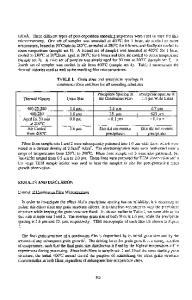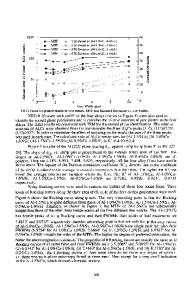Length Effects on the Reliability of Dual-Damascene Cu Interconnects
- PDF / 564,935 Bytes
- 6 Pages / 612 x 792 pts (letter) Page_size
- 56 Downloads / 460 Views
Length Effects on the Reliability of Dual-Damascene Cu Interconnects F. Wei,1 C. L. Gan,2 C. V. Thompson,1,2 J. J. Clement,3 S. P. Hau-Riege,4 K. L. Pey,2,5 W. K. Choi,2,5 H. L. Tay,6 B. Yu,6 and M. K. Radhakrishnan6 1. 2. 3. 4. 5.
DMSE, Massachusetts Institute of Technology, Cambridge, MA 02139 USA AMM&NS, Singapore-MIT Alliance, 4 Engineering Drive 3, Singapore 117576 Sandia National Laboratories, Albuquerque, NM 87185 Intel Corp, Hillsboro, OR 97124, now with LLNL, Livermore, CA 94550 Department of Electrical & Computer Engineering, National University of Singapore, 4 Engineering Drive 3, Singapore 117576 6. Institute of Microelectronics, 11 Science Park Road, Singapore 117685 ABSTRACT We have carried out experiments on dual-damascene Cu interconnects with different lengths. We find that at short lengths, similar to Al-based interconnects, the reliability of Cubased interconnects improves. Also like Al interconnects, some short Cu segments do not form voids that cause failure before back-stresses prevent the further growth of voids. However, unlike Al-based interconnects, there is no apparent deterministic current-density line-length product (jL) for which all lines are immortal. This is related to the absence of a conducting refractory-metal overlayer in Cu-technology that can shunt current around small voids. Also unlike Al, we find that at long lengths a sub-population of Cu lines is immortal. We propose that this is the result of rupture of the thin refractory metal liner at the base of the dual-damascene Cu vias. As a consequence of this complex behavior, median times to failure and lifetime variations are minimum at intermediate line lengths. INTRODUCTION Over the past few years, copper has become the metal of choice for chip-level interconnects in high-performance integrated circuits. Compared with conventional Al metallization, Cu interconnects have the advantage of lower resistivity and are expected to have improved reliability [1]. Nevertheless, failure due to electromigration (EM) remains a major reliability concern in Cu interconnects. The study reported here has focused on the effects of the interconnect line length on EM-induced failures of Cu-based interconnects. Blech Immortality and Resistance Saturation in Short Interconnects In general, the total atomic flux under electromigration in a straight segment of interconnect is described by the Blech-Korhonen equation [2, 3]: Ja =
Dc a kT
ρ | j | z*q −
Dc a kT
B
∂µ σ ∂x
, (1)
where Ja is the atomic flux, D is the diffusivity, ca is the atomic concentration, ρ is the resistivity, j is the current density, z* is the effective valence of the atoms, q is the fundamental charge, B is B13.3.1 Downloaded from https://www.cambridge.org/core. University of Michigan Library, on 28 Jul 2017 at 19:07:58, subject to the Cambridge Core terms of use, available at https://www.cambridge.org/core/terms. https://doi.org/10.1557/PROC-716-B13.3
the effective bulk modulus, and µσ is the chemical potential associated with the induced stress. The two terms on the r
Data Loading...











